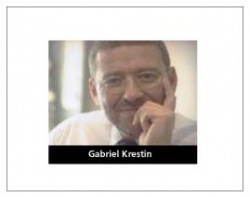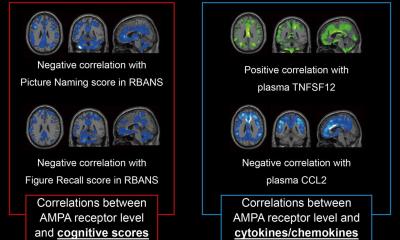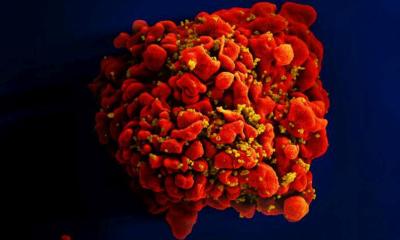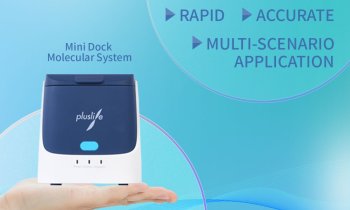EIBIR - The European Institute for Biomedical Imaging Research
Interview by Daniela Zimmermann
Aiming for European biomedical research at the highest level.

Professor Gabriel Krestin, Head of Radiology in one of Europe’s largest hospitals – the Erasmus Medical Centre, in The Netherlands – is also Chairman of the Research Committee of the European Association of Radiology (EAR) and founder of the EIBIR.
Prof. Krestin: It was our dream to carry out biomedical research on the very highest level based on the American example. In the USA, four or five years ago, The National Institute of Biomedical Imaging and Bio-engineering (NIBIB) was founded within the National Institute of Health (NIH). The latter is a huge research organisation, directly subsidised by the US Government, with around $28 billion annually – comparable with the EU budget for research in all areas for the next five years! . Now we are striving for it, too, although we don’t have an NIH equivalent in Europe. Very few European institutes organise research in a transnational manner; we organise research mainly nationally. So we want to set up something at an European level.
Early in 2003, Professor Jörg Debatin was asked to develop a strategy for European biomedical imaging research – proposals that were further developed in a second committee. We wanted to see whether there was interest in a network of existing institutes, and their availability for this, etc. Initially we only had a lot of good ideas. In 2004, I followed this up with a very small committee, which initially decided to create a ‘virtual institute’ – a network of existing, high-quality European institutes already carrying out research – and have them co-operate within the network. Subjects and research institutes were to be freely selectable. We wanted to facilitate the exchange of scientists, particularly between East and West, to jointly write proposals for the EU’s Framework Programme for Research.
At first 150 institutes registered, then another 20, all intent on working together – a basis to work on. I knew radiologists were not alone in carrying out the imaging research; I wanted to design it on a broader scale, so other medical disciplines would have the right to co-determination. In 2005, the standing Research Committee was established, and included in the statutes of the EAR. In 2006, the members, elected me as chair of the EAR Research Committee. The Research Committee consists of representatives from all the member countries. So, we have the research committee, which is fully integrated into the EAR, and we have the 170 institutes ready to collaborate.
In 2006, the EIBIR was founded as a limited liability company in Austria. The European Society of Radiology (ESR) is presently the only shareholder of the EIBIR. The ESR raised the start-up capital, but we have also invited other European organizations, like the European Association of Nuclear medicine (EANM), the European Federation of Organisations of Medical Physicists (EFOMP), the European Society of Magnetic Resonance in Medicine and Biology (ESMRMB), and The European Coordination Committee of the Radiological, Electromedical and Healthcare IT Industry (COCIR) to become co-owners.
In a limited company someone owns the majority and other partners own the minority – so the limited company consists of many shareholders, such as the ESR, EANM, EFOMP, and so on. What is the concept here? A limited company should generate money, with all its consequences.
Presently, the ESR is the main shareholder, and probably will want to keep the majority. Of course this raises questions regarding the responsibilities of minority partners. But the issue here is not money, distribution of money, profit; it’s about motivating our own ranks and limiting the influence of politics. The EIBIR is to be an organisation largely run by the scientists themselves!
So at the moment the EIBIR is like an empty pot waiting to be filled!
Yes, and everyone should put something into it. We don’t research ourselves, but aim to promote research projects, so that ultimately we can act as a consortium to the challenges of the market at a European level.
There are often binding contracts between institutes and industry that are subject to privacy laws. How do you view such partnerships?
We want to be intermediaries between industry and the best possible research institutes in various medical fields. We look for clients, such as the Max-Planck Institute, or others for whom we will undertake research contracts. Another aspect is that research is sometimes a kind of sales strategy for industry. Firms know we don’t have enough funds for research, which is why they make them available, but only if combined with the purchase of their equipment. This creates dependency, because the most financially sound institutes are actually not always the best. So what we hope to achieve is not only the research, but perhaps to advance developments with a group of people who purchase similar equipment. We are independent, can monitor quality, so we can promote cooperation without financial interests.
By deciding which institutions best suit certain task, couldn’t you create envy between individual institutes and countries?
Research projects tend to be multi-centred, with participation by an inner core of leading institutes and an outer ring of satellites. No single institute leads in all areas. Some institutes specialise in very specific fields, but also can initiate research if interested. There certainly is an element of competition – it’s not a bad thing.
How will you develop EIBIR?
This is a service organisation, offering services to its members presently free of charge. More than 170 institutions are already members and, with our success, those numbers will grow.
Initially there was very broad-based discussion within the EAR, ESR and with other organisations, as to whether we should include as many institutes as possible, or whether it was best to limit this to high-quality institutes. . For now, we have decided that it would be more politically advantageous, better for the industry and for our general effect to have as broad a base as possible.
Won’t the already better institutes continue to be favoured?
The American NIH hands out research grants based on quality, which is also starting in Europe. Our university has introduced a quality-based reimbursement for research. We receive an annual research budget, of which 25% is retained for us to actually earn it back through our own output. Of course, this will result in the smaller institutes and departments, that don’t deliver good service becoming even smaller, and larger ones growing bigger. I’m convinced the good smaller institutes will thrive in a better environment. If a very talented scientist works somewhere that’s not prepared to invest in science and offer him scope, then success will not be obvious..
Will what happens with the EIBIR be determined by its practical work?
Shareholders and members will decide how they want this organised. The structure we’ve created will guarantee that it is neither political nor will the ESR dictate alone what will happen in research. Researchers themselves will decide.
Practicality, the EIBIR offers certain services. For example, we’ll organise workshops, and facilitate the exchange of scientists: If, say, a French institute is looking for MR physicists, then we could introduce them to MR physicists in the Ukraine. We could also handle the administration to move them to those jobs for one or two years. We’ll offer access to advanced training – Master of Science, Master of Research or PhD programms – to young scientists with inadequate opportunities in their own areas; we’ll promote doctorates in imaging, which are available at some institutes but not all. That’s where we can help, in research education – and not just for radiologists.
In terms of research, to certain extent we will have to implement some ideas in a top down fashion. We’d like to propose topics and encourage participation. Industry might also introduce a topic and our institutes could do the research. But what we’d really like is that researchers themselves will come up with topics that need partnerships. Someone, for example, might want to investigate what the multi-detector CT could do for coronary arteries, but cannot do it alone because they have only 100 patients a year, not the 1,000 needed for a valid study. So the EIBIR could find someone interested in joining and working on that study. We have an organisation set up for this – the European Assessment of Imaging in Medicine – which will run multi-centre studies based on the example of ACRIN in the US.
We also look after the image processing area. Lots of our member institutes work on image processing, for example in developing imaging biomarkers – Several groups already work in those areas, and we aim to develop an image-processing platform for them. We actually have the first, very good European image processing groups working together. It doesn’t make sense for different groups to individually carry out such developments, with some joining in earlier, others later. Those are a few examples from our networking and research undertakings.
17.11.2006







